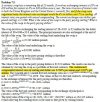You are using an out of date browser. It may not display this or other websites correctly.
You should upgrade or use an alternative browser.
You should upgrade or use an alternative browser.
Valuing a currency swap as FRA
- Thread starter Dimitriy
- Start date
Hello,
It comes from the relation r continuous = ln(1+r annual), for example the us rate continuously compounded is given by ln(1+4%)=3.922%
The general relation is given by rc = ln(1+ rk/k) equivalent to rk = (exp(rc)-1)*k where rc is the continuously coumpounded rate and rk the rate coumpounded k times in a year time.
It comes from the relation r continuous = ln(1+r annual), for example the us rate continuously compounded is given by ln(1+4%)=3.922%
The general relation is given by rc = ln(1+ rk/k) equivalent to rk = (exp(rc)-1)*k where rc is the continuously coumpounded rate and rk the rate coumpounded k times in a year time.
Similar threads
- Replies
- 0
- Views
- 1K
- Replies
- 0
- Views
- 368
- Replies
- 0
- Views
- 1K
- Replies
- 1
- Views
- 5K
- Replies
- 1
- Views
- 2K

